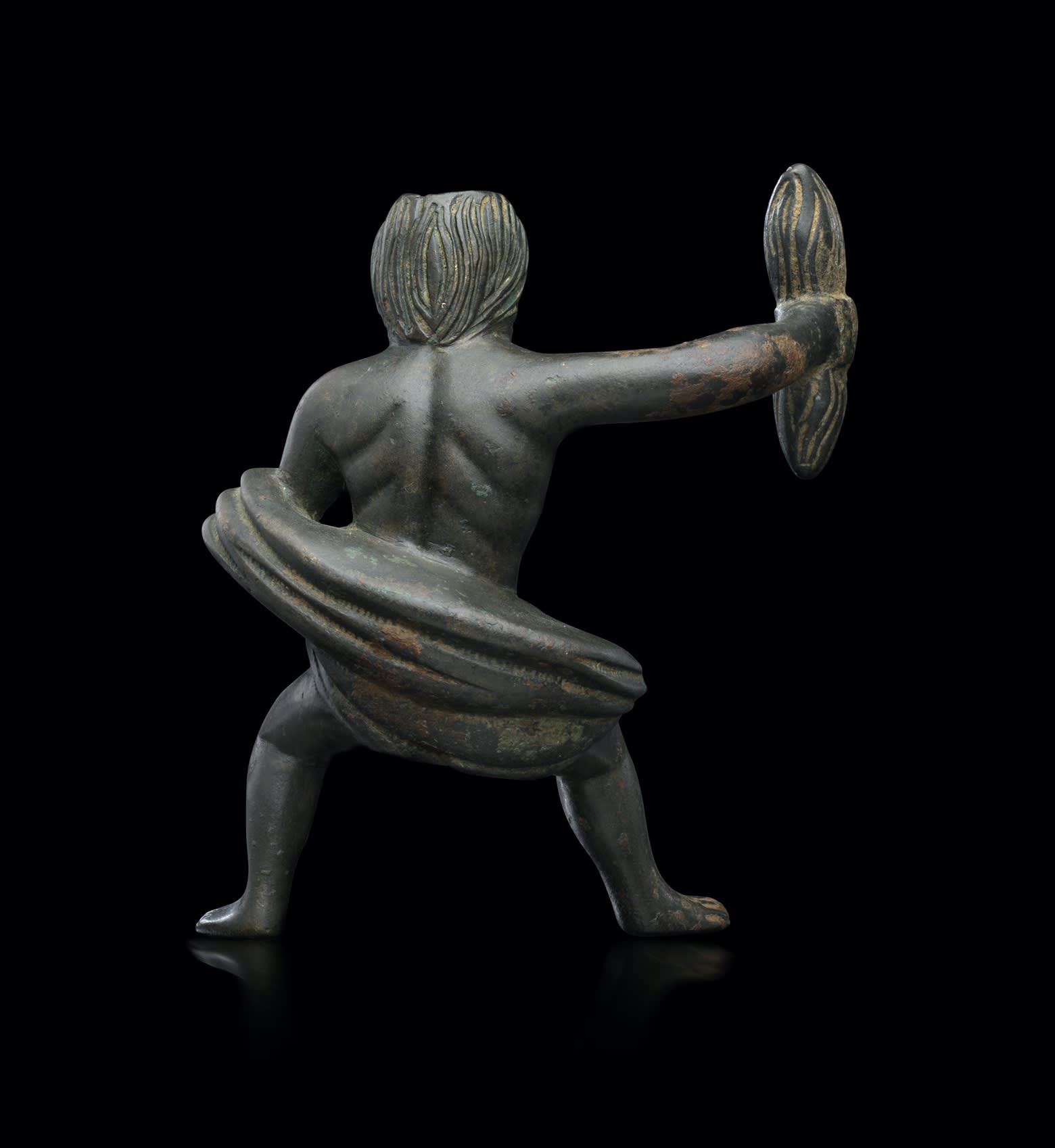
A GALLO-ROMAN BRONZE FIGURE OF TARANIS-JUPITER
Circa 2nd - 3rd century AD
Height: 12.7 cm
The posture and thunderbolt attribute allow this bronze to be identified as Jupiter, but his physiognomy encourages a specific identification of the god in his Gallo-Roman form as Jupiter-Taranis, the god of thunder, lightning, and cosmic forces. Taranis in his non-syncretic form was the enigmatic and powerful Celtic god of storms.
The Celts were made up of a diverse group of tribes that inhabited Europe during the Iron Age and Roman era. Their religious beliefs were polytheistic and centered on a pantheon of different gods and goddesses, each with their own responsibilities and attributes. Among these, Taranis was one of the most significant. The main cult centres of Taranis were in Gaul and Britain, however his worship also flourished in the Rhineland, the Danube, Spain and Ireland.
Taranis was often depicted as a strong, muscular, bearded man wielding a thunderbolt (taran in Celtic), a symbol of his control over the elements. He was also shown with a solar/cosmic wheel (or a wheel of the chariot of thunder). The wheel was an important symbol in Celtic polytheism, and they believed that the wheels of Taranis's horse drawn chariot made loud claps of thunder as he travelled across the heavens.

Celtic religious practices were mainly centered around the natural world and its cycles. The details around the worship of Taranis remain scarce, however it is thought to have involved rituals and sacrifices to appease the god and ensure favourable weather. One notable practice associated with Taranis, mentioned by both Strabo and Lucan, is the ritual of human sacrifice. According to Strabo (Geography, 4.4.5), the Celts would sacrifice humans by burning them in wickerwork figures, known as the wicker men. Lucan mentions that even wives and children were sacrificed before battle to ensure a victory, while prisoners were immolated after a win in thanksgiving to the gods.
Following the Romanisation of Gaul, Taranis became syncretised with Jupiter, king of the gods, and deity of sky and thunder. Given the hole pierced in the left hand of the above figure, the attribute he held is likely to have been a sceptre, a distinctive symbol of Jupiter. Both gods shared similar abilities, such as control over the weather, lightning, and the sky. As a result, Taranis was sometimes referred to as Taranis-Jupiter, demonstrating the close association between the two gods.
The vertical piercing throughout indicates that the figure was intended as a fitting or finial, perhaps as a decorative element to a tripod base, possibly a candelabrum or a thymiaterion (incense burner). The flat top of the head would then act as a support for the lamp or cup.
The above example of a related lampstand gives a sense as to how the Kallos Taranis-Jupiter figure would have been used. From D.M. Bailey, A Catalogue of the Lamps in the British Museum: IV, Lamps of Metal and Stone and Lampstands, London, 1996, pl. 123.
This bronze figure was originally in the collection of Sir Sidney Nolan (1917 - 1992). Sir Sidney Nolan was one of Australia’s most significant modernist artists, best known for his depictions of the history and mythology of bush life in Australia. In 1955, hungry for inspiration, Nolan and his wife travelled to the Greek island of Hydra. Nolan's visit was intended to be a brief one, but days turned to weeks and they did not leave Greece for another six months. During his stay, his interest in Greek history deepened and he became fascinated by Classical sculpture, literature, and the representation of ancient Greek warriors on vases. His interest in mythologies, doomed heroes and anti-heroes, already evident in his Ned Kelly, and Burke and Wills paintings, took on another layer of meaning.
Sir Sidney Nolan, Iliad: The horses of Patroclus, 1955-56
About the author
Hayley McCole



